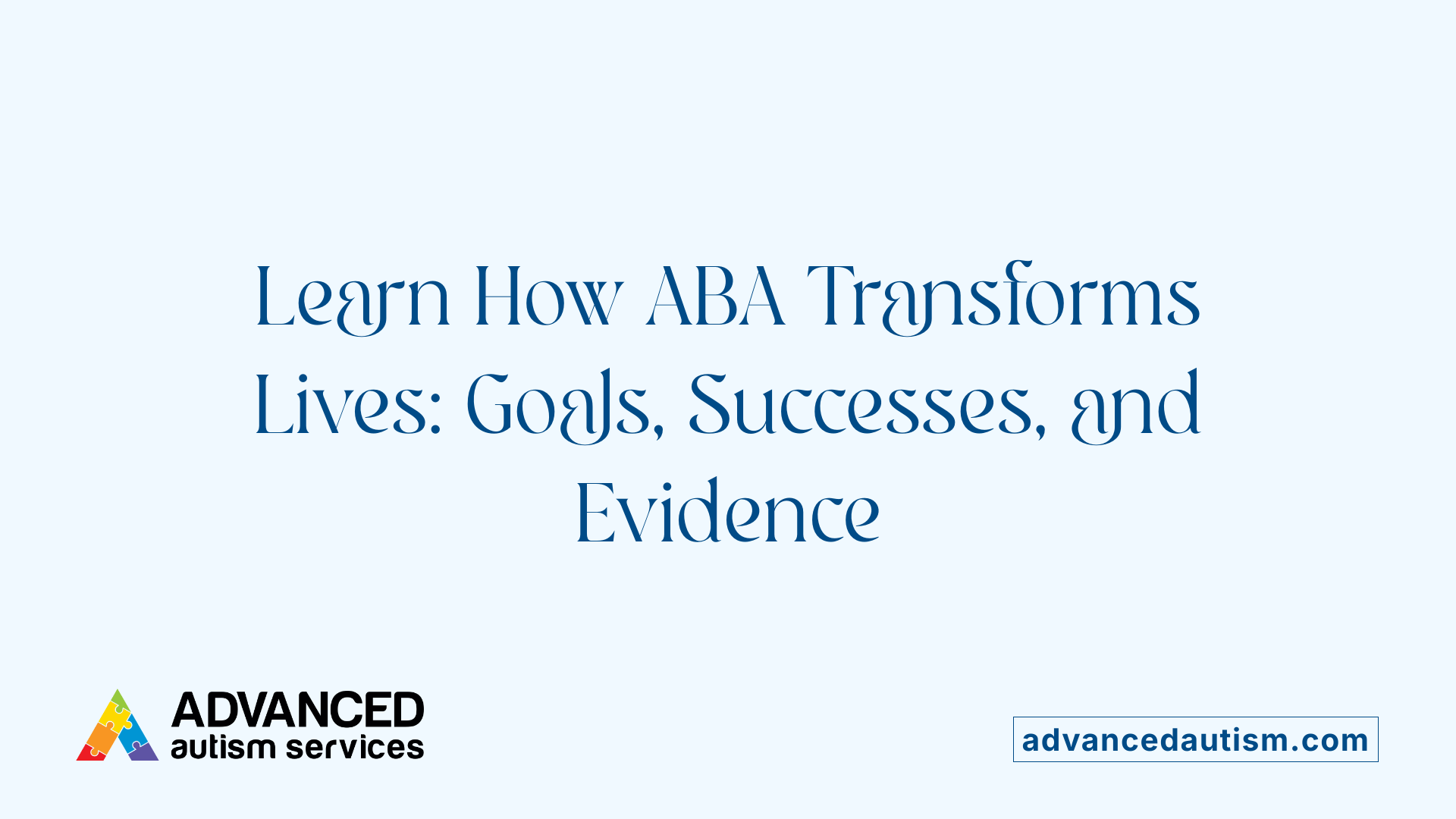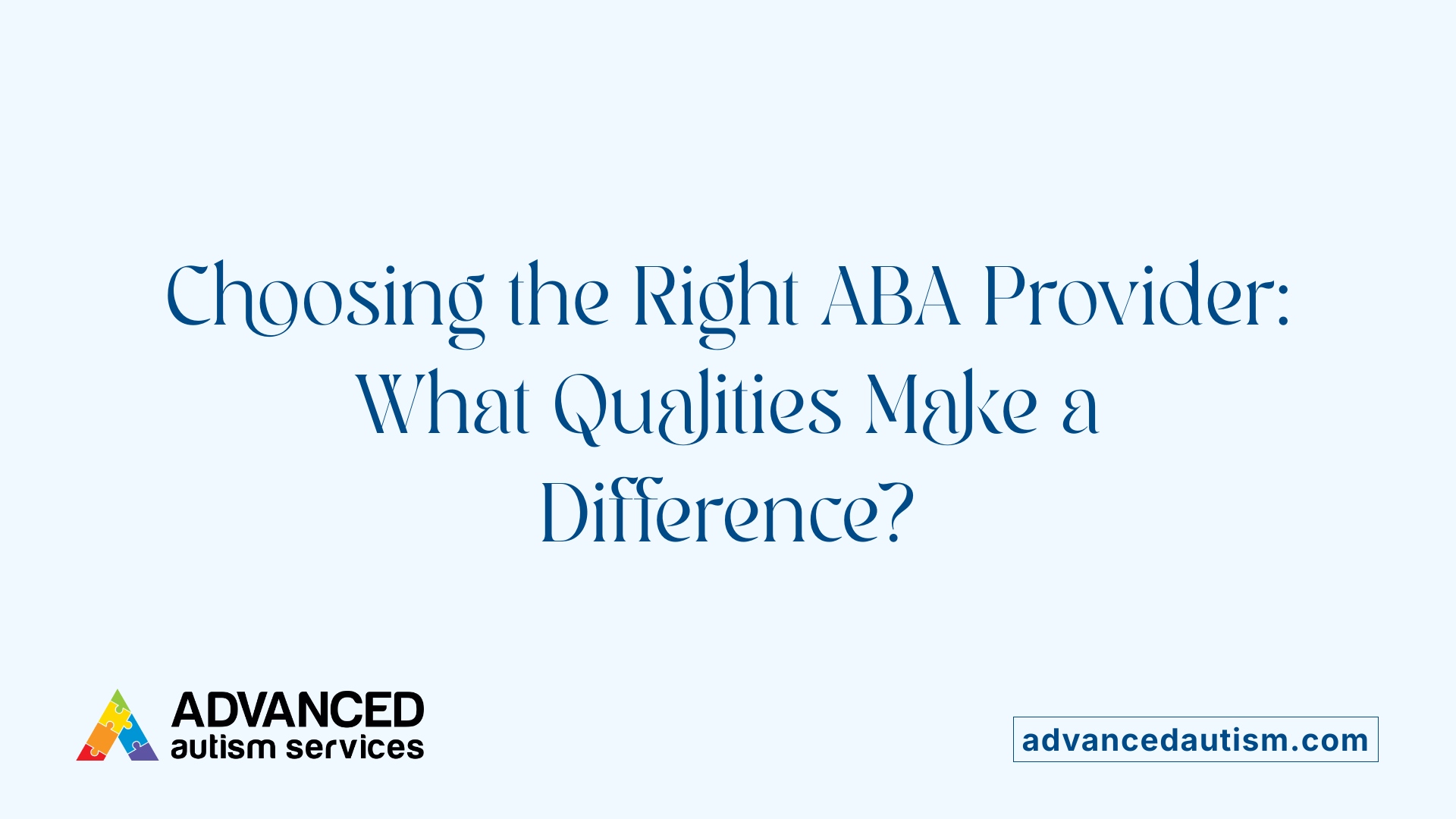Understanding ABA Therapy and Its Broader Impact
Applied Behavior Analysis (ABA) is a scientifically grounded approach that has revolutionized support for individuals with autism spectrum disorder (ASD) and other behavioral challenges. Recognized as an evidence-based best practice by leading health authorities, ABA leverages systematic, individualized techniques to foster meaningful behavioral, social, and developmental gains. This article explores the fundamentals of ABA therapy, its diverse applications, essential credentials, best practices for providers, and the importance of cultural competence, offering a thorough resource guide for practitioners and those seeking to understand this impactful field.
Foundations and Effectiveness of ABA Therapy

What is the history and scientific basis of ABA?
Applied Behavior Analysis (ABA) is rooted in the science of learning and behavior, with origins dating back to the 1960s. It is based on principles derived from studying how individuals learn and how behaviors are shaped by environmental factors. ABA systematically applies techniques to modify socially significant behaviors, emphasizing empirical evidence and observable outcomes.
The methodology employs a step-by-step approach to teaching skills, often utilizing reinforcement strategies supported by rigorous research. Its scientific foundation ensures that interventions are data-driven and specific to individual needs.
What are the goals and outcomes of ABA interventions?
The primary aim of ABA therapy is to increase helpful or socially valued behaviors while reducing those that are harmful or hinder learning. Goals include improving communication, social skills, attention span, memory, and academic performance.
ABA also targets specific behaviors like problem behaviors or unsafe actions, such as wandering or self-injury, through tailored strategies like Behavior Intervention Plans (BIPs). Daily living skills such as dressing, hygiene, and meal preparation are often included to promote independence.
Ultimately, ABA strives to enhance overall functioning, helping individuals lead more autonomous and socially integrated lives.
What is the evidence supporting ABA's effectiveness?
Research consistently shows that intensive and long-term ABA therapy can lead to significant improvements. These include increased intellectual capabilities, better language and communication skills, and improved social interactions.
The effectiveness of ABA has been supported by numerous studies and is endorsed by organizations like the US Surgeon General and the American Psychological Association as an evidence-based practice.
Data collection methods like ABC Data help track progress and refine interventions, making ABA adaptable and highly effective across diverse populations. Its validated techniques have contributed to positive outcomes for children with autism, supporting their future independence and social participation.
| Aspect | Description | Supporting Evidence |
|---|---|---|
| Cognitive skills | Improved intellectual functioning | Multiple longitudinal studies |
| Language development | Increased vocabulary and speech | Controlled trials and meta-analyses |
| Daily skills | Greater independence in daily routines | Clinical case reports |
| Social behaviors | Better peer interactions | Empirical research and reviews |
This accumulated evidence ensures ABA remains a gold standard in behavioral intervention, providing a scientifically supported method to improve many aspects of life for individuals with autism and beyond.
Credentials and Career Pathways in ABA
 To become a trained ABA therapist, individuals typically need a relevant undergraduate degree, such as in psychology, education, or behavioral science. For those aiming for advanced roles, a master’s degree in behavior analysis or a related field is essential. This educational foundation helps build a strong understanding of behavioral principles and therapeutic techniques.
To become a trained ABA therapist, individuals typically need a relevant undergraduate degree, such as in psychology, education, or behavioral science. For those aiming for advanced roles, a master’s degree in behavior analysis or a related field is essential. This educational foundation helps build a strong understanding of behavioral principles and therapeutic techniques.
The professional responsibilities of ABA practitioners vary by their credentials. Board Certified Behavior Analysts (BCBAs) are highly qualified professionals who develop and oversee intervention plans. They conduct assessments, analyze data, and guide therapy. Registered Behavior Technicians (RBTs), on the other hand, support BCBAs by implementing treatment plans under supervision. Their duties include working directly with clients, collecting data, and assisting in teaching new skills.
Career opportunities in ABA are expanding, with roles available in clinics, schools, hospitals, and in-home settings. Salaries differ based on experience, credentials, and geographic location, but typically range from entry-level positions earning around $35,000 annually to seasoned BCBAs earning over $90,000.
For those interested in entering the field, understanding the pathway is important. Educational programs, such as at Arizona State University, provide specialized coursework needed for certification. Supervised fieldwork hours are also mandatory—usually between 1,500 and 2,000 hours—to ensure practical experience.
Certification by the Behavior Analyst Certification Board (BACB) requires passing a comprehensive exam, like the BCBA exam. Maintaining credentials involves ongoing education and adherence to professional ethics. Overall, the structured training and certification process helps ensure that ABA providers are well-equipped to deliver effective, ethical, and individualized therapy.
Finding Quality ABA Service Providers

How can I find reputable ABA therapy providers?
Locating dependable ABA therapy providers begins with research and verification of credentials. Start by checking directories that list organizations accredited by the Behavioral Healthcare Accreditation Organization (BHCOE), as accreditation indicates adherence to strict standards of quality and safety. Prioritize providers that employ certified professionals, including Board Certified Behavior Analysts (BCBAs) and Registered Behavior Technicians (RBTs), to guarantee qualified staff.
Utilize resources such as professional organizations, trusted healthcare professionals, and autism support groups for recommendations and reviews. Referrals from trusted sources can help identify reputable programs with proven success.
It’s vital to verify whether the provider accepts your insurance, such as Medicaid or private plans, covering medically necessary ABA treatments. Ask about the program’s approach to customizing interventions, supervision structure, and data collection methods. Transparency regarding costs and safety procedures is also essential.
Reviewing feedback from other families and checking for safety protocols can provide additional insights into the provider’s quality standards. Prioritize providers who demonstrate a commitment to safety, transparency, and tailored care to ensure the best outcomes for your child.
What should parents and caregivers consider regarding therapist qualifications?
When selecting an ABA provider, focusing on therapist qualifications is crucial. Parents should ensure that the staff includes licensed BCBAs who oversee treatment plans and supervise therapists.
Certified staff such as RBTs should have completed recognized training and ongoing supervision. Experience working with children with autism and familiarity with individual behavioral challenges are important indicators of quality.
Ask if the providers follow evidence-based practices, utilize data-driven decision-making, and prioritize safety and cultural competence. Effective communication about treatment goals and progress monitoring is also an indicator of a well-qualified team.
Ultimately, choosing a provider with qualified, trained, and supervised staff ensures that your child receives effective, safe, and tailored ABA therapy.
How to evaluate and choose ABA service providers
Evaluating ABA providers involves checking accreditation and certifications, reviewing program approaches, and consulting reviews or testimonials. Confirm that staff members are certified by recognized organizations, and inquire about their experience with similar cases.
Ask questions related to program customization, safety protocols, family involvement, and ongoing progress assessment. A good provider will be transparent about costs, treatment plans, and how they adapt to the evolving needs of your child.
Research provider reputation by seeking feedback from other families and professionals. Visiting the facility or observing a session can also provide valuable insights into the quality of care.
Using these criteria can help you identify a reputable, qualified ABA provider committed to your child’s growth and safety.
| Criteria | Details | Additional Notes |
|---|---|---|
| Accreditation | BHCOE-accredited organizations | Indicates high standards of quality |
| Staff Certification | Licensed BCBAs, trained RBTs | Ensures qualified and supervised staff |
| Experience and Specialization | Experience with autism and individualized plans | Tailored approaches for specific needs |
| Program Transparency | Clear goals, data collection, safety protocols | Ensures safety and measurable progress |
| Insurance & Cost | Covered by Medicaid/private insurance and clear fees | Reduce financial barriers and unexpected costs |
| Feedback and Reviews | Positive family and professional feedback | Reflects quality and satisfaction |
By following these guidelines and questions during your search, you can find a trustworthy ABA provider dedicated to supporting your child's development.
Cost, Insurance, and Accessing Services
What is the typical salary of an ABA therapist?
The salary of an ABA therapist can vary depending on experience, certification, and geographic location. On average, full-time ABA therapists earn approximately $42,000 annually. Their hourly rates often range from $16 to $22, reflecting levels of experience and qualifications.
Entry-level positions, such as Registered Behavior Technicians (RBTs), typically make about $36,763 per year. Those with advanced certifications like BCaBA and BCBA usually earn between $54,000 and $70,000. Top professionals in the field, especially BCBAs, can earn over $85,000, particularly in high-demand areas like California, Massachusetts, and New York.
Salaries tend to be higher in urban and affluent areas, influenced by demand and cost of living. Overall, the salary range for ABA therapists generally falls between $40,000 and $70,000. Experienced and board-certified professionals often command a higher income, reflecting their specialized skills and responsibilities.
Are insurance options supporting ABA treatments?
Many insurance plans do provide coverage for ABA therapy, especially when it's deemed medically necessary. Programs like Medicaid, Tricare, Aetna, Blue Cross Blue Shield (BCBS), and others often have provisions to support such treatments.
Coverage details can differ based on the state, insurer, and specific policy. Typically, families are required to obtain prior authorization and submit documentation to verify medical necessity. It is crucial for families to confirm whether their insurance network includes ABA providers.
Both Medicaid and many private insurers are mandated to cover ABA services for eligible individuals. This obligation helps ensure access to vital interventions for children and adults who need them. Being proactive—checking coverage levels, understanding co-pays, and working with in-network providers—can significantly reduce out-of-pocket expenses.
Navigating financial aspects of ABA therapy
Understanding the costs associated with ABA therapy involves considering therapy fees, insurance coverage, and available financial assistance. While therapies can be costly, many programs have sliding scale fees or offer financial support options.
Families are encouraged to discuss costs upfront with providers and verify their insurance benefits regularly. Some organizations and agencies also provide resources or subsidies to assist with expenses, making therapy more accessible.
For more detailed information, families and practitioners should search resources under "Cost and insurance considerations for ABA therapy" to find guides, support programs, and policy updates that can facilitate access to this effective treatment.
| Aspect | Details | Additional Notes |
|---|---|---|
| Typical Salary of ABA Therapists | $36,763 (RBT) to over $85,000 (BCBA) | Varies by experience, certification, region |
| Insurance Support | Many plans cover ABA, including Medicaid, Tricare, Aetna, BCBS | Coverage depends on state, insurer, policy specifics |
| Costs & Financial Support | Out-of-pocket, sliding scale fees, subsidies | Confirm coverage, seek financial aid when available |
More Resources: Search for "Cost and insurance considerations for ABA therapy" for guidance on navigating financial aspects and accessing support services.
Ethics, Cultural Competence, and Inclusive Practice in ABA
Is ABA therapy harmful?
When practiced ethically and within professional standards, ABA therapy is generally regarded as safe and effective, especially for individuals with autism and other behavioral challenges. The Behavior Analyst Certification Board (BACB) emphasizes core principles such as beneficence—doing good—and nonmaleficence—avoiding harm—along with respect for clients' rights. Practitioners are expected to undergo rigorous training, adhere to ethical guidelines, and continuously update their skills through professional development.
Properly implemented ABA therapy involves tailoring interventions to meet individual needs, ensuring that strategies are respectful and beneficial. When these standards are followed, ABA helps improve communication, social skills, and daily functioning. However, concerns about harm can occur if practitioners neglect ethical principles, use inappropriate procedures, or operate outside their scope of competence. In such cases, unintended negative effects like increased stress or discomfort could arise.
The overall safety of ABA depends heavily on adherence to ethical practices, supervision, and a personalized approach. Responsible practice emphasizes respect, consent, and responsiveness, minimizing risks and maximizing positive outcomes for clients.
Empowering Professionals Through Knowledge and Standards
ABA therapy represents a dynamic, science-driven approach to supporting individuals across the lifespan, with a focus on ethical practice, cultural competence, and evidence-based techniques. The wealth of resources available—from formal certifications and training programs to inclusive practice guidelines—empowers practitioners to deliver high-quality, individualized care. Recognizing the importance of diversity, ongoing education, and adherence to professional standards ensures ABA remains a safe, effective, and equitable intervention for all populations. As the field continues to evolve, staying informed and connected through reputable articles, research, and professional networks will remain essential for advancing practice and achieving positive outcomes.
References
- Applied Behavior Analysis (ABA) | Autism Speaks
- Resources for ABA Therapists to Create More Inclusive Spaces
- ABA Articles - Special Learning
- Resources - Blue ABA
- ABA Articles - Special Learning
- Board Certified Behavior Analyst
- How to Become an ABA Therapist - Drexel University
- NYS Applied Behavior Analysis: License/Certification Requirements
- Applied Behavior Analysis (ABA) | Autism Speaks
- The Top 10 Reasons Children With Autism Deserve ABA - PMC



